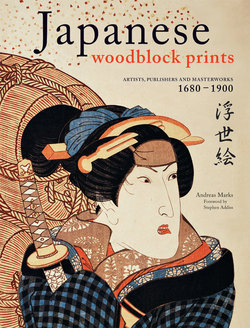Читать книгу Japanese Woodblock Prints - Andreas Marks - Страница 29
На сайте Литреса книга снята с продажи.
ОглавлениеKiyonaga
1752–1815
Family name: Seki. Given names: Ichibei, Shinsuke. Art surname: Torii.
Kiyonaga, born 1752, was the son of a book dealer from Motozaimokuchō Itchōme in Edo. Early in his life, presumably in 1765 when he was 14 years old, he became the student of Torii Kiyomitsu but his works also show influences of Suzuki Harunobu, Isoda Koryūsai, and Kitao Shigemasa. Kiyonaga initially focused on actor prints drawing his images from the frequent visits to the close-by Ichimura and Nakamura kabuki theaters. A narrow hosoban format print of the actor Segawa Kikunojō II (1741–1773) from 1767 is the earliest known design by Kiyonaga. Kiyonaga was 16 at that time and actor prints in this format were extremely popular. Though actor prints and billboards were his specialty at the beginning of his career he is especially known for his beautiful women. For forty years, between 1771 and 1811, he also worked as illustrator of picture programs (e-banzuke) and books.
The figure on the left side of page 74 dates from 1778 and is an early warrior print by Kiyonaga, capturing the horse ride of Musashibō Benkei and Tosabō Shōshun. During the 1780s, Kiyonaga became the leading designer of beautiful women that are exceptionally tall with their heads only one-seventh of the total stature. With his full-length portraits, beautiful women became subjects for large format (ōban) multiple sheet compositions from around 1784. He set these women from the pleasure quarter into a landscape by using a Western style of perspective. Around 1787, he seems to have succeeded his teacher as fourth generation head of the Torii family. After 1794, when Utamaro took over the lead in designing beautiful women, he stopped designing prints on a large scale and concentrated on surimono, paintings, and illustrations.
Kiyonaga’s print designs appeared in different formats, like ōban, aiban, chūban (medium print), hosoban (narrow format), or “pillar prints” (hashira-e). During the almost fifty years of his career as a print designer, he worked for at least 23 different publishers.
His last known print dates from 1813. He died on the 21st day of the fifth month 1815 and is buried at the Ekōin Temple in Edo’s Honjo district. His posthumous Buddhist name is Chōrin Hideki Shinshi.
early 1780s Two geisha viewing cherry blossoms on a hill. Hashira-e. Publisher: Nishimuraya Yohachi. Library of Congress. Pins 1982, fig. 681, and Chiba City Museum of Art 2007, fig. 205, no. 420.
1784 Kintarō playing with demons. ōban. Publisher: Nishimuraya Yohachi. Asian Art Museum, National Museums in Berlin. Chiba City Museum of Art 2007, no. 106.
c.1795 Courtesan going to bed, looking at another courtesan sleeping, from the series “Ten Types of Beauties in Pictures” (Jittai e-fūzoku). ōban. Publisher: Takasu Sōshichi. Collection Peter Rieder. Chiba City Museum of Art 2007, no. 12-4.
1778 Musashibō Benkei and Tosabō Shōshun. Hosoban nishiki-e. National Museum of Ethnology, Leiden, The Netherlands. Chiba City Museum of Art 2007, no. 398.
1789 “Act 7 of the Treasury of Loyal Retainers” (Chūshingura shichidanme), from the series “Anthology of music” (Ongyoku shū). ōban. Asian Art Museum, National Museums in Berlin. Chiba City Museum of Art 2007, no. 10-1.
1779 “Star Meeting”, from the series “Holiday Entertainments in the Flower Quarter” (Hanagaku gosechi asobi). Aiban. Collection Peter Rieder. Chiba City Museum of Art 2007, no. 151-4.
c.1779 “Night rain in the fifth month” (Chūka yau), from the series “Eight views from the four seasons” (Shiki hakkei). Chūban. Publisher: Nishimuraya Yohachi. National Museum of Ethnology, Leiden, The Netherlands. Chiba City Museum of Art 2007, no. 158-3.
c.1783 “Courtesan Hanaōgi of the ōgiya” (ōgiya Hanaōgi), from the series “Models for Fashion—New Designs as Fresh Young Leaves” (Hinagata wakana no hatsumoyō). ōban. Publisher: Nishimuraya Yohachi. Collection Peter Rieder. Chiba City Museum of Art 2007, no. 2-10-a.
